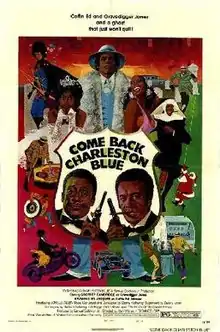Come Back, Charleston Blue
Come Back, Charleston Blue is a 1972 comedy film starring Godfrey Cambridge and Raymond St. Jacques, loosely based on Chester Himes' novel The Heat's On. It is a sequel to the 1970 film Cotton Comes to Harlem.
| Come Back, Charleston Blue | |
|---|---|
 Theatrical release poster | |
| Directed by | Mark Warren |
| Produced by | Samuel Goldwyn Jr. |
| Written by | Peggy Elliott Bontche Schweig Chester Himes (novel The Heat's On) |
| Starring | Godfrey Cambridge Raymond St. Jacques |
| Music by | Donny Hathaway |
| Cinematography | Richard C. Kratina |
| Edited by | George Bowers Gerald B. Greenberg |
| Distributed by | Warner Bros. Pictures |
Release date |
|
Running time | 100 minutes[1] |
| Country | United States |
| Language | English |
Plot
Coffin Ed Johnson and Grave Digger Jones are confounded by a string of strange murders in the neighborhood of Harlem, New York. The murders themselves aren't nearly as bizarre as the calling card left by the murderer: a blue steel straight razor. Legend has it that this was the calling card of Charleston Blue, a vigilante who tried to rid the neighborhood of all criminal elements using a straight razor. Blue, having disappeared years ago after he went after Dutch Schultz (with his trusty straight razor) was considered dead by all except his girlfriend, who kept his razors locked away until his "come back."
Soon after the murders start it is discovered that the razors were missing and all evidence points to Joe Painter, a local photographer, who has begun dating Carol, the beloved niece of mafia errand boy, Caspar Brown. Joe and Brown are at odds over Caspar's refusal to help Joe kick the mafia out of the neighborhood, so Joe enlists the help of a group of brothers and the spirit of Charleston Blue. However, Coffin Ed Johnson and Grave Digger Jones discover that Joe's plan doesn't seem to be exactly what he claimed it was.
Cast
- Godfrey Cambridge as Grave Digger Jones
- Raymond St. Jacques as Coffin Ed Johnson
- Jonelle Allen as Carol
- Percy Rodriguez as Bryce
- Minnie Gentry as Her Majesty
- Peter De Anda as Joe Painter
- Leonardo Cimino as Mago
Production
The film was shot in Harlem,[1] which required producer Samuel Goldwyn Jr. to negotiate with CORE and other groups over their demands for "money, jobs and control."[2]
Reception
This film was a sequel to the film Cotton Comes to Harlem: appearing two years later, it opened to mixed reviews, with critics feeling it was decent, but not riotous like the original 1970 film.
In April 1972, less than three months before the film's release, Time magazine called the film "part of a new Hollywood wave of eminently commercial movies by blacks about the black experience," a wave that included Sweet Sweetback's Baadasssss Song, Shaft, Shaft's Big Score, Cool Breeze, Buck and the Preacher, The Legend of Nigger Charley, Super Fly, and Blacula.[2]
A.H. Weiler, reviewing the film for The New York Times, called it "only occasionally funny or incisive" with a "convoluted plot and dialogue that is often too 'in' for the uninitiated."[1]
| Come Back Charleston Blue | ||||
|---|---|---|---|---|
| Soundtrack album by | ||||
| Released | 1972 | |||
| Recorded | 1972 | |||
| Label | Atco Records | |||
| Producer | Donny Hathaway, Quincy Jones (supervision) | |||
| Donny Hathaway chronology | ||||
| ||||
Soundtrack
All tracks written by Donny Hathaway except "Little Ghetto Boy" (Earl DuRouen / Edward Howard) and "Come Back Charleston Blue" (Donny Hathaway / Al Cleveland / Quincy Jones).[3]
| Track | Song | Length |
|---|---|---|
| 1 | Main Theme | 02:20 |
| 2 | Basie | 03:53 |
| 3 | String Segue | 00:34 |
| 4 | Vegetable Wagon | 01:07 |
| 5 | Harlem Dawn | 01:38 |
| 6 | Scratchy Record | 03:09 |
| 7 | Explosion | 00:23 |
| 8 | Hearse to the Graveyard | 02:46 |
| 9 | Switch "Charleston Blue" | 00:32 |
| 10 | Come Back Basie | 02:36 |
| 11 | Detective's Goof | 00:28 |
| 12 | Grave Digger Jones & Coffin Head Johnson’s Funeral | 03:02 |
| 13 | String Segue | 00:17 |
| 14 | Little Ghetto Boy | 03:50 |
| 15 | Hail to the Queen | 00:21 |
| 16 | Drag Queen Chase | 00:47 |
| 17 | Bossa Nova | 01:47 |
| 18 | Tim's High | 01:30 |
| 19 | Furniture Truck | 01:18 |
| 20 | Liberation | 02:52 |
| 21 | Come Back Charleston Blue | 02:04 |
In November 2007, Rhino Records released a remastered version of the soundtrack album, which included two new tracks, an alternate version and a live version of "Little Ghetto Boy."[4]
See also
References
- Weiler, A. H. (June 30, 1972). "Come Back Charleston Blue, Sequel to Cotton in Harlem". The New York Times. New York City: The New York Times Company. Retrieved October 30, 2010.
- Time Magazine Staff (April 10, 1972). "Show Business: Black Market". Time. United States: Time USA, LLC. (Marc & Lynne Benioff). Retrieved October 30, 2010.
- "Come Back Charleston Blue". Allmusic. Retrieved 2010-10-30.
- "Come Back Charleston Blue". Rhino Records. November 12, 2007. Archived from the original on 2011-06-15. Retrieved 2010-10-30.